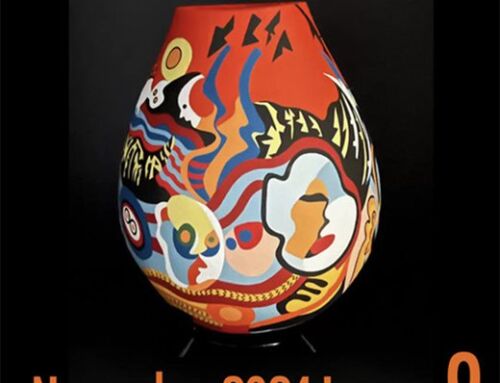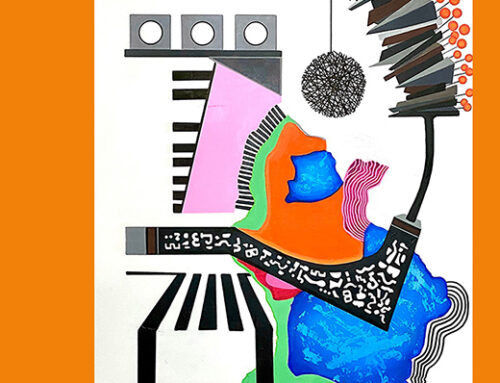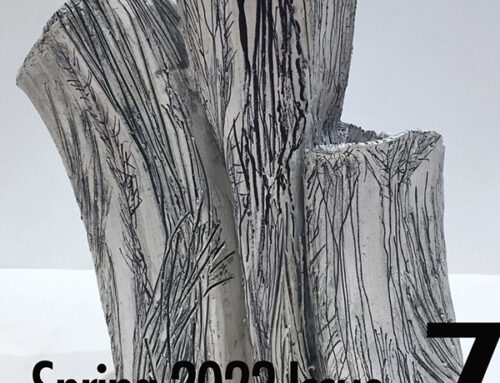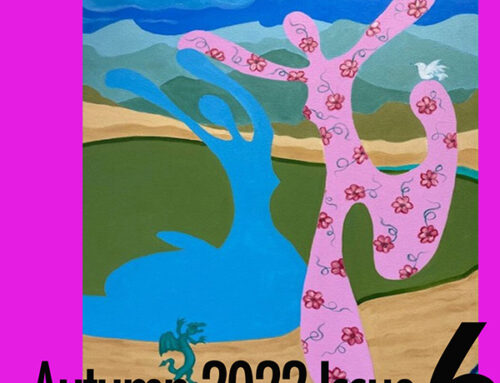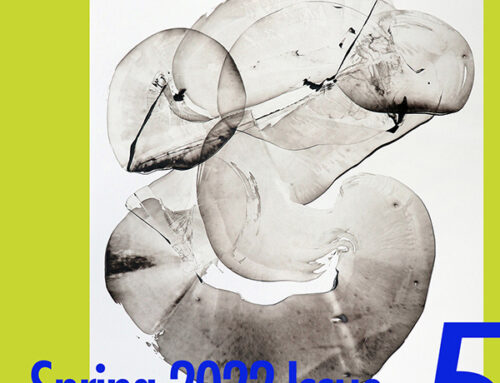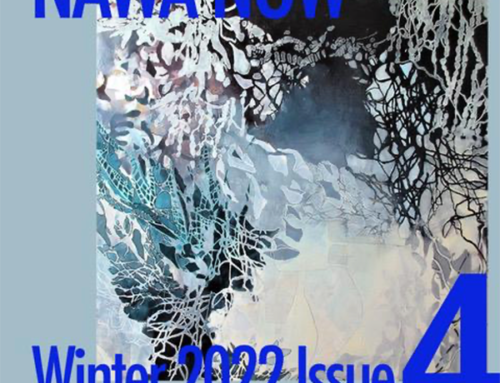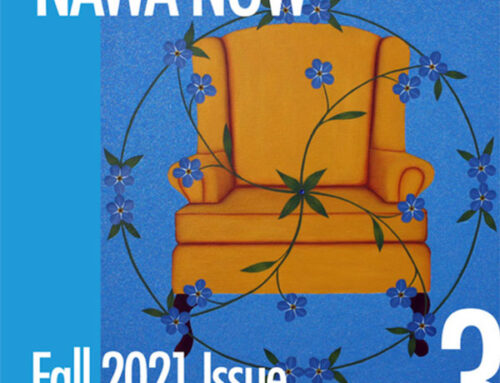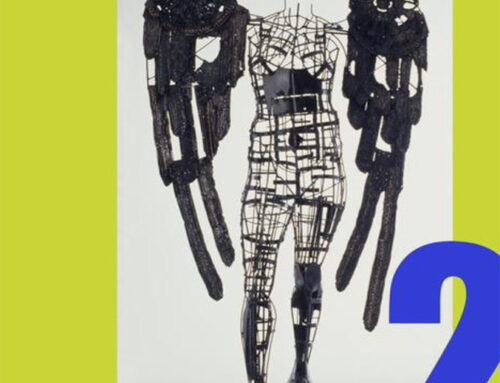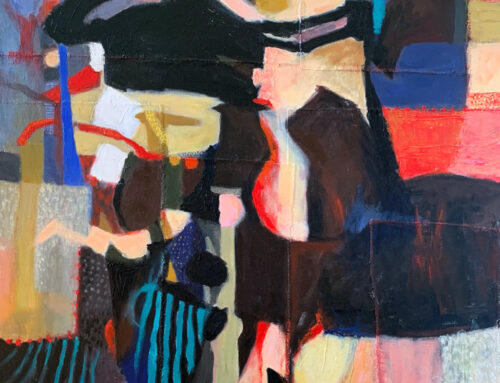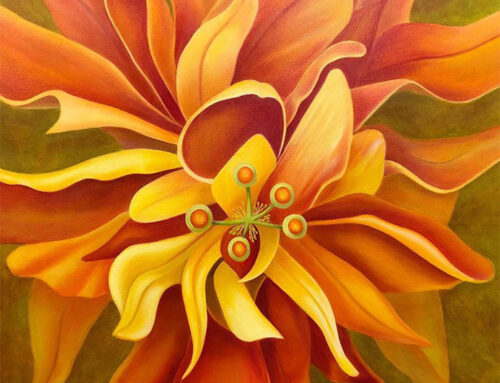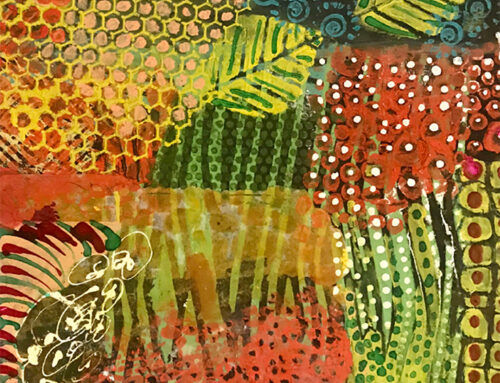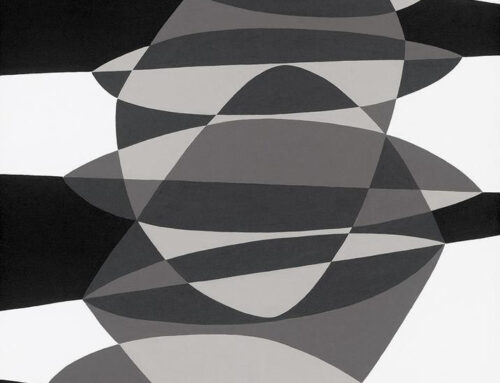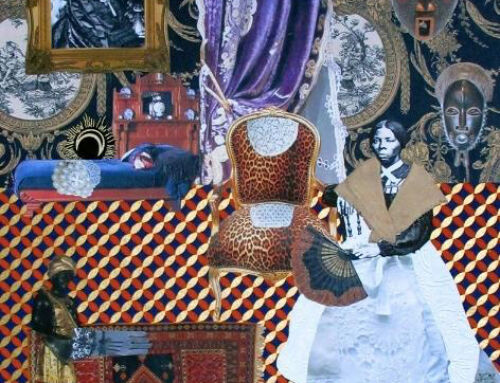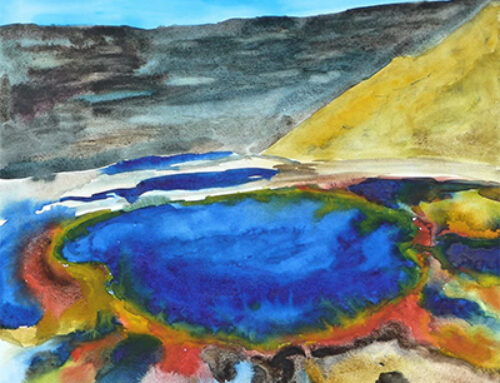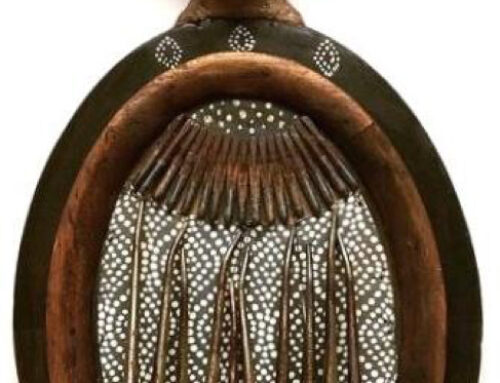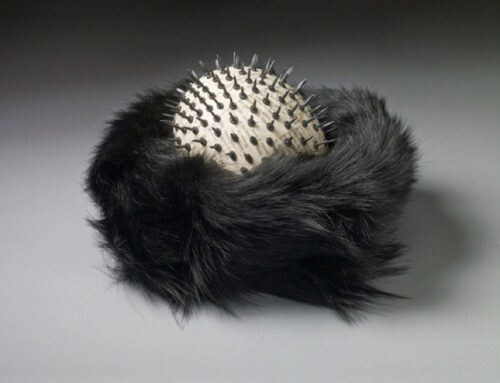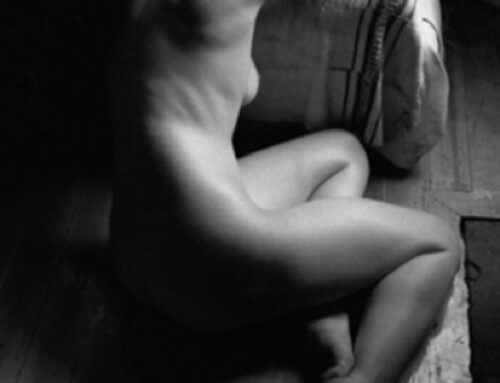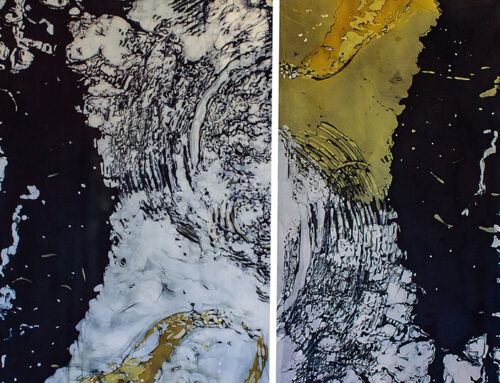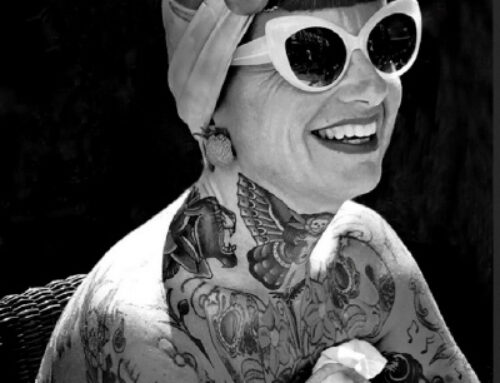
Summer 2020

Lucinda Abra, Transformation,
Mixed media: Encaustic, oil, collage on wood, 24 x 30 in.
ABOUT Transformation
Transformation is mixed media, consisting of encaustic, oil paint and collage on wood. The painting conveys the difficult task of metamorphosis. For the butterfly to emerge, the caterpillar’s body must dissolve while a new form, the chrysalis, becomes a protective shell. Inside the cocoon, the new form develops. It feels so frightening to change, to let go of our old ways and enter into such trying circumstances. But it is within these very efforts that we become stronger and more resilient. We are transforming into women rebirthed, stronger, braver and more truly beautiful each in our own hard won way. To live is to change.
I always start by making a collage, which I use as a sketch. Then I add acrylic to the image. The work is photographed, enlarged and printed on watercolor paper. From there, I cut Transformation out as if it was a puzzle. With a detailed drawing hanging on my easel as a reference, I embed each piece in encaustic. Once the wax sets, the fun begins as I paint over the “sketch” with both oil paints and encaustics to bring out my vision.
PRESIDENT’S CORNER
 The global quarantine situation is a blessing a curse for the artists: While working tirelessly in the studio or at home on new art projects, sometimes we feel that our pets and family are our only audience. At other times we feel internationally exposed once we exhibit our art anywhere in the world on social media and virtual platforms.
The global quarantine situation is a blessing a curse for the artists: While working tirelessly in the studio or at home on new art projects, sometimes we feel that our pets and family are our only audience. At other times we feel internationally exposed once we exhibit our art anywhere in the world on social media and virtual platforms.
It is OK to feel both; it is OK to ride an emotional rollercoaster because that is all part of our unpredictable reality. What is important is to stay true to yourself and adapt to what feels right to you. Some like risky challenges, some like creative rituals rooted in traditions. The beauty is in the uniqueness of our differences interwoven in a single tapestry of our time together.
Here at NAWA we celebrate the creative expressions of women who partake in the narration of the present-day issues – the Pandemic, Global Ecology, Black Lives Matter, Centennial of Women’s Right to Vote, U.S. Educational System, Effects of Social Distancing on Mental Health, U.S. Health Care System, Global Economy, upcoming U.S. Presidential Elections, Social Media and Entertainment industries.
NAWA does not promote any political campaign or any religion. However, it certainly reflects our culture through the artworks of our members. Take a look at NAWA’s recent projects, besides four online exhibitions on NAWA’s website.
Art in Conversation with Farrin, our popular series on NAWA YouTube Channel, has acquired nearly 100 subscribers in three months.
Our Instagram @the_n_a_w_a following grew to over 460 followers since April. Please continue to share your art and tag #VirtualNAWA on your Instagram.
We are currently working on the new program series NAWA Educates, which will provide our members with practical and promotional materials biweekly through lectures and demos.
NAWA’s Small Works and Beyond online show has a record number of entries. I invite you to check out this exhibition on our home page here.
I also encourage all members to apply to NAWA’s 131st Annual Members’ Exhibition, the first online Annual in the long history of NAWA. I am looking forward to seeing your new art in the new virtual Gallery.
Thank you for your dedication and your continuous support. Keep creating!
Best,
Natalia Koren Kropf
A WORD FROM BIANA
 Dear NAWA Community,
Dear NAWA Community,
The past three months have been exciting at NAWA.
We have launched our Art in Conversation with Farrin Series on our newly installed YouTube channel. The series has presented us with great opportunities to feature our members and share our great talents with the world. As a result, we have seen an increase in our member engagement, and our channel has seen a rise in followers.
Our very successful series, Artist of the Day, also has experienced great feedback. We thank all of you who have emailed us and told us how inspirational and uplifting it is.
We are also very excited to announce our new initiative, called NAWA Educates. NAWA Educates aims to provide a platform for our members to learn about different topics, from how to promote their art to how to write the press release. We hope that this series will inspire NAWA artists to take their work and business side of art management to another level.
We have started to receive submissions for the 131st Annual Exhibit. This year the exhibit will be hosted on our website and featured on our main page from October to December. All accepted work will also be available for sale through our e-commerce site on our website. If you have not done so, please consider submitting your work to this wonderful annual event.
In addition to all these wonderful happenings, we have also decided to update our member database. You will be receiving an email from us about updating your information, and we hope you will find the time to assist us with the information.
The Annual Ballot email for this year has gone out in June. We asked our members to cast their votes and share their thoughts/feedback. Thank you to all of you who have voted. We do hope to continue working on your behalf and making NAWA stronger.
This year NAWA has given many awards. If you would like to establish an award in the name of someone special, please email office@thenawa.org, and we will be happy to assist you with that.
I hope that you and your loved ones are staying healthy and safe, and I wish you continued success and creative expression.
Warm Regards,
Biana
RED CARPET NAWA MEMBER
Ferrin Zad
(NAWA recently started a new online interview show which is hosted by Ferrin Zad. We thought it a great idea to introduce her to our readership, as she has been so generous in introducing us to a wider audience. SB)
Q. Can you tell me how your idea of hosting an interview show for NAWA began? I assume you have always had an interest in the arts. Were you comfortable with your role as host? And have you ever considered or been in that role before?
A. The idea came from one day in which Biana and I were talking and she said: “How about having an online show?” so we started throwing out ideas and after many discussions the idea developed. I was nervous and anxious for the first two shows, but I’m pretty settled in now. I’m an art professor and I have been around and talked about Art & Artists for as long as I can remember. This is my first role as the host, but I never imagined myself doing something like this.

Canvas Panels and Watercolor, 11 in. x 14 in. 2012
Q. What about your own early beginnings? Were you interested in the fine arts as a child or a young adult?
A. Academic work comes first for me, but I also love to design and paint. I was born and raised in a small town in the Northeast of Iran. I always had big dreams, so I had to work since I was 12 years old. I started to design and weave carpet when I was 13 years old (there wasn’t any type of copy machine, so I created my own lightbox to copy more of my designs for a carpet weaver.) This work helped pay for my advanced education and the big dreams that I had. When I came to Harvard as a scholar fellow I joined a group. “Harvard Art Club” was where I met a few ladies who encouraged me to bring out the artistic part in me again. They are and will always be my mentors and teachers and best friends. So, I should say art was a part of me from childhood.
Q. In terms of women’s issues, how have you handled your professional and at home role? You have one daughter, I believe. How do you see her role in today’s times as she matures?
A. I’m a mom, wife, teacher, and an artist, I love art, I’m always looking for new ways and new materials to try. My husband is very supportive and is always helping me with my art and dreams. He knows I’m obsessed with my art making. My daughter loves to paint, she is almost three years old and whenever I paint, she wants to paint next to me. She is a good listener, kind and polite, and I hope she grows up to be kind and strong and has an artistic heart.

Creation,Watercolor, 18 in. x 25 in. 2019
Q. How do you see your interview show shaping up in the future? Do you see the platform changing and/or expanding over time?
A. My plan is to continue as long as we can. I would love to have the opportunity to have conversations with talented women from all around the world. As a woman, I’ve struggled a lot. I’m from a country in which women’s rights don’t mean too much and they don’t get chance to grow in society, never mind succeeding in terms of art. Being an artist was disgraceful to my family and being a painter as my Dad termed it, wasn’t a good thing for a girl. We’re living in a great country in which women have every chance to grow and succeed as artists. Although women artists are not as widely accepted as men are, we need support, need to be promoted, and need to grow stronger. So, I’ll continue to help women like myself to rise and to have their name and their works out there.
Q. What do you see as the greatest challenges facing you in today’s climate?
A. Challenges, hmmm, there are challenges always, sometime more, sometime less. We can adopt and use the best out of it. I look at challenges as opportunities, nothing can stop me. My husband always jokes, saying; “Are you going to stop” or “Isn’t that enough for today?” and I answer, “No, never”. No challenge or failure can stop me, it never did, and it never will. I am not afraid of challenges or failing. If we are afraid to fail, we will never learn. So, I’m trying my best and everyday learning something new. As Prophet Muhammad said: “Seek knowledge from the cradle till (thy) grave!”
Q. How can NAWA best reach out to its members and a larger audience?
A. I think what we are doing is a great way to connect with our members, as well as extend the members’ family of NAWA. Having contests, exhibitions, competition, auctions, nationally and internationally, these are all great ways to extend, engage and reach out to members and allow members to respond back to NAWA. I personally want to thank NAWA, I feel I found a home with NAWA.

Weave: Hand tufted, Quality: Tufted, Knots per Sq Inch: NA, Total Weight: 10 Oz per Sq.Ft., Pile Weight: 2.5 Oz. per Sq.Ft., Pile Height: .1 inches, Material Used: 100% Indian Bikaner Wool
NAWA SHOUT OUTS

MARGE LOUDON MOODY
Marge was born of Scottish parents, spent her formative years in East Africa and has lived in the US since 1983. She currently resides in South Carolina, where she was Professor Art at Winthrop University, Rock Hill, SC for 30 years. Her broad background has been influential in her work in a number of ways.
She paints large acrylic paintings on canvas, and makes collages of varying size on paper or on panel. In her artist statement she says:
“My work is inspired by the experience of my environment, close to home, distant, and from my imagination. Using non-representational imagery, the work describes the ‘spirit’ of place. I work thematically and make abstract acrylic paintings on canvas, collages, drawings and mixed media pieces, which, through a rigorous process of working and reworking composition and art elements, arrive at a harmonious expression of the essential nature of the subject. Life experience may be similarly layered. Subject matter may serve as metaphor for intangible ideas.”
Marge has an active on-going exhibition record, in solo and group shows. Her work has been exhibited throughout the South Eastern US, Chicago, New York City and in her native Scotland. Among exciting things that have happened to her are winning a juried solo show (‘SM15’) at FRONT Art Space, New York, in 2015 (the smallest gallery in the city, and recently being accepted to the Visiting Artist/Visiting Scholar program at the American Academy in Rome, Italy.

Surface Light series: Evening, Acrylic on canvas, 48 in. x 48 in. 2019
Marge is married to Phil Moody, photographer, and has two grown sons. When she’s not in her studio she loves to travel, exercise, ‘putter’ in the garden and spend time with her two small granddaughters.
Please visit her website www.margeloudonmoody.weebly.com to see more of her work, as well as the show she would’ve had in New York at the NAWA, June 2020, titled ‘New Work in Collage’. Marge looks forward to rescheduling this exciting opportunity to show at the NAWA gallery, hopefully in 2021.

Fox River, Collage on panel, 20 in. x 20 in. 2020

Cereus, Acrylic on canvas,48 in. x 72 in., 2019

Subway series: 35:55 (Grey Dot), Collage on panel, 10 in. x 10 in. 2020

WENDELIN RAY
My name is Wendelin Ray, and I am a photographer currently living and working just outside of Philadelphia. I grew up in suburban Pennsylvania as part of an artistic family; my Dad has been a sculptor all his life and my Mom is a successful writer and oil painter.
In this environment, I took to the creative process at an early age and was drawing and painting as soon as I was big enough to hold a marker in my hand. By the time I attended Syracuse University to study fine arts, I had decided to become a sculptor. After two years of study and six years of working in ceramics, I stopped using clay altogether and began my work as a fine-art photographer. I started with a 35mm film camera and printed black and white photos on paper at my community arts center darkroom. During this time, I started exhibiting at local coffee shops and galleries.
 Now, as an advanced photographer, I continue to use a 35mm camera but work exclusively in digital media. I also exhibit more widely and am part of two associations, National Association of Women Artists and Media Arts Council. Although I have done some commercial work, my first interest will always be fine-art photography.
Now, as an advanced photographer, I continue to use a 35mm camera but work exclusively in digital media. I also exhibit more widely and am part of two associations, National Association of Women Artists and Media Arts Council. Although I have done some commercial work, my first interest will always be fine-art photography.
I am frequently asked what subject matter inspires me as a photographer. The focus of my work and portfolio is predominantly urban architecture and street scenes, seascapes and beach culture, but I enjoy taking pictures of people and animals as well. Because of quarantine, I recently have experimented with self-portraits, and have embarked on a series involving different personas. Self-portraiture is challenging both technically and artistically, but also very enjoyable, and will be an ongoing pursuit. The photographs accompanying this statement are all self-portraits using various outfits and wigs to convey the different moods and expressions I am feeling at home that day. Some of the photographs are quite amusing, such as the image of me looking playfully into a frying pan; others are more serious, such as the image with the red wig and hand at my throat.
Overall, the hope is that viewers can relate to some of the characters, and that the images will evoke an emotional response. It has been a difficult time in isolation for everyone, but for me, focusing on creating original work has been an enriching experience in my personal development as an artist.


TOOLS OF THE TRADE
CAROL NIPOMNICH DIXON
I’ve been creating art ever since I was a child — drawing, painting, photographing, and doing embroidery which my Russian-born grandmother taught me.
Even as I still paint large canvasses using oil paint, and teach courses to adults in drawing and mixed media collage, my embroideries are my most distinctive works. They feature bright color and texture, taking on intensity because of their small scale.
I use traditional 3-ply cotton embroidery thread and traditional stitches, such as satin stitch, outline stitch, and chain stitch. I also use free-form stitches, handling them as if they were brush strokes. On some works, I increase the shading by applying Caran d”Ache. Often, I incorporate torn photo fragments or contemporary found objects into the stitchery, such as flattened crushed cans or museum pins. I enjoy juxtaposing the old with the new.
While some pieces are totally non-objective, I’ve often been inspired by the world around me — nature, places visited, varied cultures, historical eras, and art over the ages ranging from Ming Dynasty squares to paintings by Klimt, Kandinsky, and Krasner.
Carol was featured on NAWA’s You Tube channel in “Art in Conversation with Farrin” on July 31, 2020. To view, go to: www.youtube/carolnipmonichdixon

Gallery Hopping, Embroidered assemblage on felt, 15 x 15 in.

Times Square, Embroidered assemblage on felt, 13 x 13 in.
WHERE WE ARE NOW
Susan Phillips
I ran from NYC on March 19th, 2020. I ran because I was petrified, being in the “most susceptible” group. That category knew nothing about my teaching, artistic or musical life. It didn’t care whether I was a good or bad human being; or that I was the Nawa Gallery Coordinator. It just knew that I was OLD. And I knew it was looking for me.
I am fortunate to have a small house, upstate in the woods. I have been here since, except for two days, when I ran back to get my mail and rescue whatever was left of my plants, looking over my shoulder the whole time. I am a photographer collage artist. They are separate areas for me. But for the first time ever, I produced a photo collage, using bits and pieces from old graffiti photographs. This is the result entitled Covid Screams. It reveals my feelings better than words could have done.

Susan Phillips, Covid Screams, photo collage on paper, 2020
Loretta Ana Kaufman
Tennessee
My thoughts when we returned to Nashville after attending NAWA’s Small Works Winter reception in early February were that my husband and I were fortunate that this did not take place later in the month.

Animated Forms I: Environment Series,
12 x 9 in, acrylic on canvas, 2020
Tennessee opened state parks the third week in April. We live in Metro Nashville with a population of 1,900,000 and our directives are more restrictive than less populated areas of the state. Restaurants and some retail establishments reopened in Nashville at 50% capacity the second week in May with several parameters. On the fourth week in May, we reopened at 75% capacity in Phase 2. At the end of the first week in June there was an uptick in case numbers and a decision was made to remain at Phase 2 until certain benchmarks were met to begin Phase 3.
There are many guidelines here, such that residents should wear masks or face coverings at all times when leaving home. During the past month, some appear to be following our mayor’s directives, but sadly a great deal of them have not. As we continue to see the daily addition of confirmed COVID-19 cases in Metro and the state, it will be interesting to see what progress we make throughout the summer and fall.
My studio space is on the ground floor of our home with lots of natural light and an expansive view to the rear of the property. Groundhogs, possums, chipmunks, turkeys, the occasional bobcat, numerous species of birds, and countless other tiny creatures are residents or frequent visitors. With plants and trees leafing out due to the early spring and much rain, there is an incredible amount of activity here that I find is so important at this moment in time. Painting smaller and incorporating more detail in the canvases than I usually do has helped to keep me focused. This diptych was produced between February and May.

Animated Forms II: Environment Series, 9 x 12 in, acrylic on canvas, 2020
Mary Atkinson
Greetings from Santa Cruz, CA
Santa Cruz has been sheltering in place since March 13th and continues to do so as Covid19 cases continue to slowly rise both in Santa Cruz and California. In general, however, Santa Cruz County has done remarkably well in comparison to others due to strict adherence to Alerts from local and State governmental agencies. Santa Cruz is a sensitive, peace-loving village where you cannot toss a stone without hitting artists of multiple mediums. I am so grateful to live where I do – a stimulating, creative, free-thinking community.
I am personally proud of California’s response to the Pandemic even though it has been challenging and the urge to ‘get out’ has been there. My family and I are safe and well and do not personally know anyone affected by the disease.
My last project was mixed-media. I created and produced eight (8) personal Art Books comprising both original small works, prints of original works, personal photographs taken by me, songs that I have written and/or Rumi poems. I’m attaching pictures of a few of those.
During this time of turmoil in the world due to the Pandemic, and our country in particular, fighting both disease and racial inequality, I am hoping for changes in the form of enlightenment, expressions of human understanding, kindness and mindfulness. As an expression of my prayers and hopes, I’m attaching “Connect the Hearts”, water media on paper, 30 x 22, which I hope says it all.
I am proud to be an artist expressing emotions and channeling love through Art. Please, everyone, keep the faith that Good shall prevail over evil. Thank you! www.marysawyeratkinson.com

Even the Queen, aka Self Portrait, Wedding Series, 22 x 34 in.
Watermedia, liquid acrylic, caron d’ache, collage
Judith Carlin’s Life in Miami
In May 2019, after spending most of my adult life (and we’re talking decades here, many, many decades) in NYC, my husband Roy Lowrance and I moved to Miami.
Was this the right thing for me to do? Hmmm. NYC is the art capital of the world and I’m an artist. I love the museums, the galleries, the cafe society and the people of New York. Could I adjust? My paintings are about how the world affects people and how people affect the world. They have a very strong humanitarian slant. NYC has been perfect for me.

In front of a section of Louis Rosemont’s mural “Ms. Annacarona”. Little Haiti
So here is my experience. We moved into a condo on Biscayne Bay in Downtown Miami with a direct water view. Instead of seeing the streets of Greenwich Village and all the zany goings on of people, I now see boats, cruising around, with zany going ons of people on the boats. When I look out I see a million paintings. So, in some, ways, this was a parallel but different experience to my NYC apartment. Sorta like NYC if I lived in Battery Park City but with palm trees.
To my delight, Miami and Miami Beach (two separate cities but around six miles across the bay from each other) are filled with museums, filled with galleries, filled with murals and filled with public art. A few of my favorites are the Rubell Museum; ICA, the Institute of Contemporary Art; the Pérez Art Museum; the de la Cruz Collection; the Bass Museum and MOCA, the Museum of Contemporary Art.
The Wynwood neighborhood, known for Wynwood Walls, has edgy murals from artists all over the world. The whole neighborhood has been muralized. Is that a word? All of a sudden, I’m thinking off the canvas and onto the wall. Wait, I can have both.
In Little Havana, there’s Cuban Art everywhere. Rooster sculptures line the streets. The bold paintings jump off the walls. People are dancing in the streets. I’m dancing in the streets. Hey, I do that in NY too. Am I living in a parallel universe?
Little Haiti. I knew I was in a different neighborhood just from the murals. I was fortunate enough to meet Louis Rosemont, a phenomenal Haitian artist. He explained the symbolism and history that is embedded in Haitian art.
I found the Design District to be filled with stunning public art, sleek abstracts and expensive installations they call store windows. Did I get transported to NYC’s Upper East Side somehow? No, look, there’s a palm tree.

In front of Lillana Porter’s mural “Alice Goes Back”. Downtown Miami
My Downtown Miami neighborhood is also filled with public art and galleries and museums. And like NYC there’s art in the subways. The subways here are not underground but elevated and are called metromovers or the metrorail depending on which lines you’re taking.
But what about NAWA? How could I leave my NAWA? Well, there’s a NAWA Florida Chapter. Guess what, Roberta Millman-Ide is the president. I know Roberta from NY. She welcomed me with open arms. All of NAWAFL did. We have monthly art salons and I even get to see Susan Hammond.
Since I’m influenced by what’s going on around me, I’m sure my paintings are being influenced by Miami as well. I’m trying to think of ways my art can make a dent in society. I spend a lot of time on my balcony and I do take walks with all my gear on and avoid getting too close to people. I’ll be happy when we can get back to normal, the new normal, the new abnormal, any kind of normal. In many ways I feel like I am writing with paint.
Miami has not been a hard adjustment for this artist. It’s a very international and multicultural, crazy, wild, friendly city, teaming with artists just like….Okay that’s it, from now I’m renaming Miami, Tropical Manhattan.

Frida Kahlo cement mixer. Downtown Miami

The Ultimate High, oil and acrylic on canvas, 24 in. x 30 in.

The World is Going Crazy And So Am I, oil and acrylic and salt on canvas, 30 in. x 24 in.
Lucinda Abra
New York
There is a lot of ebb and flow to these days. A deluge of change has made the smallest experiences more noticeable, deeper and more profound. Being sequestered for so long has had such a powerful effect on our psyches. Having been employed since fourteen, suddenly that flipped on its head, as the stay at home order was enacted. There were days when I felt adrift in the studio, with the various works piling up, while an unaccustomed dreamtime replaced artistic drive. I started winter’s end as one person; as time has crept on, I’ve morphed into another. A person I am just beginning to know.
Like many of you, loved ones have been washed away, on the rocky shoreline of the virus. If it wasn’t obvious before, a truth has been illuminated. Love binds, feeds, laughs, cries, inspires and supports. It comforts, protects and guides.
So I walk back into my studio, unencumbered by the past now gone, reaching to a more encompassing compassion for all living beings. The alchemy of the art supplies pulls me to my heart center, as the scent of turpentine once again perfumes the air. I will speak for the dead. I will speak for the living, using my skills and create a new path less travelled. Hope to find you along the way, my treasured community, as we join in constructing a bridge between then and a freshly birthed now.

Lucinda Abra, Transformation,
Mixed media: Encaustic, oil, collage on wood, 24 x 30 in.
Gail Skudera
In April and May, when the pandemic hit home for all of us, I needed to look outside of my usual studio practice to find a way to express this new reality that we are living with. I became interested in working with cut foam blocks to make mono prints with drawing component from my sketchbook.
Putting aside the loom woven photo collages that I’ve been making for several decades placed me in a position of vulnerability to honestly pursue something new.
With a background in weaving and textile printing, moving to a printmaking process made sense except for leaving my primary source behind—the photograph. Working with the immediacy of drawing and a woven grid format, I experienced a new freedom. In these woven mini-prints, the imagery of a hummingbird, caught up in the rhythm and movement of its own surroundings, is both fleeting and tangible at the same.

Sparks Fly, block print woven, 6 in. 2020

High Place, block print woven, 6 in. 2020

Taking Root, block print woven, 6 in. 2020

Red Clover, block print woven, 6 in. 2020
Kate Kennedy
South Carolina
Everything changed so quickly, and we are all left wondering what the new normal will become as time progresses. I never imagined returning to my home on the little Island of Folly Beach, SC, would involve a going through a Police check point to help keep tourists off the beach. I hope everyone stays safe and well and we all come out on the other side, healthy and grateful for all the good and simpler things in life.
I tried to stay focused on painting and was able to complete “Carolina Sunrise” oil on canvas, 36 x 40. I switched gears a few weeks into quarantine and worked on small paintings that would involve a little humor to lighten up life. I painted my own social distancing art critics who keep me company on late night paint-a-thons. “Pelican Pete” oil on canvas 12 x 28, “The Art Critic”, 10 x 16 oil on canvas (goat), and “Ostrich Blues” oil on canvas, 16 x 18 are favorites who frequently give me sage advice. (images attached).
(For a further update on South Carolina’s efforts, please go to the CHAPTER CHAT section in this newsletter.)

Carolina Sunrise, oil on canvas, 36 in. x 40 in.

Pelican Pete,
oil on canvas, 12 x 28 in

The Art Critic,
oil on canvas, 12 x 18 in.
Saundra Renee Smith
As the pandemic began to spread, our lives turned upside down, I felt the artist inside me slowly begin to withdraw into a dark space. I felt the lid of this dark space begin to seal shut when art galleries began to request that I retrieve my works from them, stating that “we are closing our doors forever.” A dark space of grief and loss started to return once again but this time with a new face, and a new name, wearing a mask to conceal its true identity. Hopelessness had returned. The impact of Covid-19 was like an old enemy bringing a new and greater threat to my life as an artist.
The artist within withdrew into the darkness and would have remained there, except for an unexpected visit by two of nature’s smallest creatures. I was sitting on my back porch, hoping the new day would rejuvenate my creativity, when I saw the strangest thing. A beautiful brown turtle, and a wide-eyed tree frog began making their way together across my wooden deck. I was immediately fascinated by the colors, and wondered how on earth an odd couple such as this had managed to journey together. I watched them silently as they moved closer and I began to feel inspiration as their colors and patterns spoke to my inner artist in the dark space. Their purpose became clearer as my light of creativity began to stir, and I understood their presence and meaning.
In the Gullah culture, the turtle reminds us of the need for patience, as the race is not always given to the swift. The frog helps us to understand there are many stages of change, but each is a necessary part of the transformation process and brings with it the promise of the appearance of something new and superior. “Emerge from the darkness with new hope, transformation requires patience”, was the significance of their visit.
As artists and people in the sea of humanity, we can choose to create tragedy, but we can just as easily create joy, happiness, hope, and light. The choice is ours because inwardly, we are the Creators.

Emerge from The Darkness, 8 in. x 10 in. acrylic on canvas
Mimi Herrera-Pease
My personal life as well as my painting practice have been greatly altered since the pandemic. I am just now beginning to visit my studio in San Francisco as lock-down guidelines are beginning to lift. I am grateful to have a space in my home that works well as a studio. In fact, I’m getting to like walking in with my first cup of coffee in the morning in my pajamas to begin dabbling with paint.
In February, my mother passed away. She was an artist and a huge influence on me personally and artistically. She had a fresh eye and could see issues with my work that I couldn’t resolve myself. She was my biggest fan and I hers. She left my siblings and I a Victorian house that we have been renovating since her death. It keeps me busy during the pandemic as well as helping with the grief. I am able to see all that she had accomplished in her life – making art, traveling, gardening, collecting, and being the best mother and grandmother ever.
In the midst of dealing with the horrible pandemic, came racial tensions and police violence against black and brown people. As a Latina, this deeply affected me. I went into a depression. As an artist, I was able to channel my feelings in the studio as I didn’t want to risk my health to protest. Below is a piece that I completed quickly, which is rare for me. It was imperative to finish it before George Floyd was laid to rest.

In Loving Memory, George Floyd,
2020, Mixed media on canvas, 12 x 12 in.
ON YOUR RADAR
SUSAN ROTHENBERG
Susan Rothenberg, whose flayed, lushly foreboding paintings radiated a Paleolithic grandeur and helped usher figuration back into an art world that had declared it extinct in the 1970s, died on Monday at her home in Galisteo, N.M. She was 75. (Randy Kennedy, NY Times, May 18, 2020)

Susan Rothenberg in her studio in Galisteo, N.M. in 2008. Her figurative works pushed hard against received notions of painting in the late 1960s, when Minimalism and Conceptualism were dominant.Credit…Jason Schmidt
This segment normally focuses on exhibits we want to bring to your attention. But the passing of this artist is a moment we felt warranted your attention. Rothenberg cut a sharply memorable swath in the art world she inhabited, one that will not be forgotten, by her creative contemporaries and the public alike. (SB)

For the Light
Susan Charna Rothenberg was born on Jan. 20, 1945, in Buffalo, N.Y., to Adele (Cohen) Rothenberg, a president of the Buffalo Red Cross and one-time assistant to the city’s mayor, and Leonard Rothenberg, an owner of a supermarket chain. As an art student at Cornell University, Ms. Rothenberg dreamed of becoming a sculptor but switched to painting after the head of the sculpture department flunked her, seemingly displeased with fetishistic pieces resembling alarm clocks with teeth that she had made under the influence of Lucas Samaras.
Her first solo show in 1975, at 112 Greene Street, depicted the pared-down form of a horse cleaved by a vertical or horizontal line. Critics Peter Schjeldahl and Hilton Kramer were in awe of these early works. If Andy Warhol had his soup cans, Rothenberg had her horse paintings, “something like a stand-in for the figure,” she said.
By the 1980s, Ms. Rothenberg’s horse motif gave way to heads, hands, boats, bones, birds, dogs, goats, human forms in raw brushwork that had affinities with that of Giacometti, early Cy Twombly and late Philip Guston but was unmistakably her own. “I almost feel I can take the most banal subject matter and make a good painting out of it,” she said. “Growth is more important to me than talent. I was not the best kid at art school, by any means. I’d love to know what that best kid is doing now.”
Susan Rothenberg was definitely one of the best kids.

Susan Rothenberg
Red Pillow Dog, 2009-2010,
oil on canvas
29 5/8 x 34 in
WHO’S ON BOARD
MARK M. ALTSCHUL

Mark M. Altschul
I am somewhat of an anomaly on the NAWA Board. I am not a woman and I am not an artist – I can barely draw a straight line with a rule! In fact, I have no actual art training after about the third grade. My involvement with NAWA started in 1998 when I was asked to provide some legal help and advice at the request of another art group. Over the years I became a friend of NAWA and many of its members. I became a Board member on the first Board with outside Directors and then became the Corporate Secretary. I believe that I am the longest serving Board Member.
I am an attorney in Manhattan specializing in Wills, Estates and Trusts, Real Estate and Commercial matters. At the time I became acquainted with NAWA, I was single, living in Manhattan. I now live in Tenafly, New Jersey with my wife Audrey and my children Ben, Chloe, Liam and Noah. In addition to being the Corporate Counsel to NAWA, I am general counsel to several businesses in the New York Metro Area. For the past few years, I have been serving as the President of Gesher Shalom Synagogue in Fort Lee, New Jersey. I also represent other art groups and artists.
Whenever Board discussions turn to the matters of art and style, I know that I don’t know anything about such matters, so just listen. I don’t claim that I have any style. As many of the Board members will attest, I have a joke for every occasion! I have done Standup Comedy for fun – but not profit! I have seen many changes over the years with NAWA. I have always been very optimistic about NAWA’s future. I am glad that I have been and continue to be a part of NAWA.

Clockwise: Naomi Altschul (Mark’s mom), Audrey Altschul (Mark’s wife), Mark Altschul, Susan G. Hammond
CHAPTER CHAT
SOUTH CAROLINA
Kate Kennedy
(Readers are encouraged to read Kate’s reflections during the pandemic in our special WHERE ARE WE NOW? section of this quarterly’s newsletter.)  This coming year we will be doing group and solo exhibits in our fabulous new online Museum. Enjoy your tour of the virtual galleries named to honor special members who helped form NAWA Chapters: Susan G. Hammond Gallery, Nella Lush Gallery, and the Liana Moonie Gallery. Entry portals for SC/MA/FL’s First Virtual Experience Exhibits can be accessed at www.nawasc.org. Our first six days open we have had over 900 visits to our website from the US, CA, UK, Italy and beyond!
This coming year we will be doing group and solo exhibits in our fabulous new online Museum. Enjoy your tour of the virtual galleries named to honor special members who helped form NAWA Chapters: Susan G. Hammond Gallery, Nella Lush Gallery, and the Liana Moonie Gallery. Entry portals for SC/MA/FL’s First Virtual Experience Exhibits can be accessed at www.nawasc.org. Our first six days open we have had over 900 visits to our website from the US, CA, UK, Italy and beyond!
All the SC Exhibits in the future will be using virtual experience galleries in conjunction with physical gallery exhibits. We hope to drive more traffic through SEO for greater visibility and sales. We encourage you to help promote our exhibit by visiting and using the invite button on your favorite painting to post to your social media or share it with a friend. It is exciting technology we all need to learn how to use. Our fall exhibits are moving forward, the galleries and museums are open to the public again with social distancing guidelines. We have a busy fall schedule with exhibits at the Art League of Hilton Head Island Gallery, and The Vendue Art Hotel in honor of author Pat Conroy You can learn more about our exhibits at https://smarterentry.com
For information on joining the SC Chapter, please email artdivas@nawasc.org.
We also encourage readers to enjoy the video of our exhibit – SOME LIKE IT HOT.

Nella Lush Gallery
Susan G. Hammond Gallery

SLIH Gallery
Lian Moonie Gallery
Susan Irish, one of our members, found a way for artists to be self-sufficient and collaborative in this difficult time. She discovered #artistsupportpledge. which has now gone international. The concept is a simple one. Susan is posting images of her work to sell for no more than $200 each (not including shipping.) Anyone can then buy the work. Every time she reaches $1000 of sales, she pledges to buy another artist’s work for $200. Artists supporting other artists! She then created #artistsupportpledgechs for Charleston, SC and set up a Facebook page for Artist Support Pledge Carolinas too. Now other areas are creating their own hashtags. People want to support the arts, especially now that artists are unable to host physical exhibits. Here is an idea that links those aspects together. The UK hashtag currently has 47K followers. It is a great way to shop the world or as local as Charleston. Check it out! #artistsupportpledge.

Susan Irish, KIRSHNER, abstract oil, 10 in. x 10 in.
I have talked to many of our SC members and most are struggling in some way. The hardest hit are our members whose sole support is sales of their art. So many have had all their winter, spring and summer events canceled. We will be working hard to get our members additional visibility to improve their sales this year by expanding our digital footprint. Everyone on the board spent time learning to create digital videos and slide shows to promote artwork of our members. Check out: https://www.youtube.com/watch?v=WQ2Ha_5wwhY&list=PLbbt2XfLjaW3T-xqffSMzbu-dnYyY-CmB
FLORIDA CHAPTER
by Roberta Milman-Ide, President

I hope this email finds all of you well. As I’ve said before, we are living in strange times which requires distancing ourselves from one another, but artists have thrived even in the most difficult times in our history and we are now finding new avenues for our creativity to be shared with each other, our friends and our world!
Our online salons on Zoom continue with great success. I am currently working as the mediator for the Florida members on the third Wednesday of each month. These are informal gatherings which will enable participants to share their work and ask for feedback as desired.
(In the Florida/Massachusetts/South Carolina PR for the combined “Some Like It Hot” online show, it is described as a sassy, bold exhibit to kick off the summer, and shake off the pandemic blues. The show runs through August 25th.)
In December, Art Angels of the SubTropics for our hardest working volunteers will be at my new studio and a good place for our members to celebrate the holidays
We also look forward in March of next year to two shows: a nature themed show at The Miami Botanical Gardens Art Gallery and a combined show with our NAWA South Carolina (Sister) Chapter (exhibit may be moved from the Fish House Art Center Gallery, Port Salerno, FL. To downtown Stuart, FL due to Covid-19). Both shows Celebrate Women’s History Month. We will be having our Annual Luncheon/Dinner in Miami, the same day as the Botanical Gardens Show Reception.
We are also at the beginning stage of hosting a NAWAFL Professional Development Workshop, at Rowlins College, FL (possibly set for 2022) as well as firming up other Exhibition dates.
The only thing slowing down scheduling is this Virus. But it shouldn’t slow us artists down. All things will pass. And, with patience and sheltering in place, we can still make the best of our current situation.
MASSACHUSETTS CHAPTER
Jennifer Jean Costello, President
Dear NAWAMA Family,
Even in the most “normal” of years, summer brings a time of reset and travel. But if the last three months have taught me anything, it is how inherently resilient and optimistic our creative family is. This doesn’t mean that every day of remote life has been smooth or that all these changes didn’t bring about big feelings in all of us. They did. But I’m something of an optimist by trade and by experience, and I can’t tell you how proud I am of our NAWAMA family – for your adaptability, your willingness to try out “the new” – and just your general capacity to take this crazy Spring and see the best sides of it. This makes our ‘my’ heart smile.
Of course, the truth is that many uncertainties remain. We don’t yet have guidance from the State that will help us with our resuming ‘in person’ gatherings, so we have been planning pretty much for as many scenarios that are out there! First of which, continuing our online ‘Shops’. We have had a sale and look forward for many more. This means all shows going forward will have a shop in addition to the venue presence.
And my heart feels two things intensely, and at the same time, for the needed conversations and actions taking place around the injustices and inequities we’ve all seen and have been talking about of late. My first feeling is, as I’m sure it has been for all of us, intense pain – for lives lost, for opportunities cut short, for the systemic problems that our country at times makes only halting progress towards addressing. But my heart also feels intense hope as we change with the world. This is our task, and I can’t think of a group of practicing artists better equipped to take this on.
Last, our Chapter continues to grow with a healthy roster of 2020 exhibitions: www.nawama.org/calendar Sheltering in Place Social, along with announcing our Scholarship 2020 recipients Wrileidy Lopez, Hallie Gagnon and Carmela Murphy. These bright and talented young women received $1500 each with the third underwritten by Signature Consulting.
We believe in the power of art and look forward to seeing everyone in-person soon.
Be well and stay inspired.
In addition to the July update, is a walkthrough:
https://www.youtube.com/watch?v=5624uc3x8_g&feature=youtu.be&blm_aid=4769792 from one of our current shows https://nawama.org/she-store
LETTERS

Hubris, 35cm X 35cm, mixed media with collage and raptor wing on linen. 2020
Dear Friends,
You are in my thoughts as I send this. I hope everyone is safe and healthy and I can look forward to seeing so many of you again.
Once again, the Capelouzos Family Art Museum in Athens, Greece has invited me to participate in their 35 x 35 Project.
Sitting in the sun in the summer of 2019, I was deeply distressed by the arrogance of the new world order. The myth of Icarus emerged. Fake news, fake leadership, fake tan, fake hair, fake wings. I began a series of work on this myth. In this painting there is the scientific diagram of a bird’s wing suggesting the scholarship of Daedalus. I found a real raptor’s wing, a predatory bird, on my country property and collaged it on the work. The painted raptor shadowing the Labyrinth symbolizes the COVID-19 pandemic and in another version of the myth it is the Minotaur who actually triumphs with hubris.
This painting will be part of the museum’s permanent collection, and it will be featured in a coffee table book later on in the year.
Best,
Denise Shaw
NAWA READS
By Nancy Vineburgh

The Equivalents: A Story of Art, Female Friendship, and Liberation in the 1960s
By Maggie Doherty
Reviewed by Nancy Vineburgh
In the fall of 1960, Radcliffe, the prestigious, sister school of Harvard, announced an unprecedented fellowship program targeting the so-called, marginalized class of ‘mothers’.
The brainchild of Radcliffe President, Mary Bunting, this new program, the Radcliffe Institute for Independent Study, was intended to combat what she referred to as the “climate of unexpectation” facing women in mid-century America. Bunting felt too many accomplished female undergraduates were giving up their dreams of becoming scholars or artists because of the conflicts inherent in balancing homemaking, child rearing and wifely responsibilities. The Radcliffe program’s charge was to help get ‘intellectually displaced women’ back on track.
Twenty-four highly competitive women were accepted from over two hundred applicants. The program’s prerequisites were a Ph.D. or the equivalent in training in an artistic craft, and highly promising activities or accomplishments. This book is about five women, four of whom were in the first cohort of the Radcliffe Institute for Independent Study – two poets, a painter, a sculptress, and an author who entered the program in the second year. They called themselves the equivalents because none had attained a Ph.D., but all possessed the equivalent in artistic experience and recognition, and importantly had well-articulated goals for this program. Each woman received a stipend of $3,000 (about $25,000 in today’s dollars), access to Harvard’s library system and resources, and a private office at 78 Mount Auburn Street.
In this writer’s opinion, the book rests on two pillars: the first is the relationship between the poets, Anne Sexton and Maxine Kumin, who both lived in Newton, Massachusetts and whose friendship preceded their enrollment at Radcliffe; the second involves the philosophy and juxtaposition between Bunting’s view of women, education and the world, and the views of Betty Friedan as expressed in The Feminine Mystique.
Sexton and Kumin had met at an adult education poetry workshop in the Boston area prior to their stint at Radcliffe. Their friendship evolved relatively quickly; their personalities were polar opposites. Sexton, born into a WASP family of great wealth, suffered severe mental illness and lifelong anxiety. She wrote from her personal experiences of institutionalization and the battling of her demons. Her voice as a poet was one of great emotion and poignancy. Kumin, from a Jewish family and plagued by a sense that she never fit in, wrote neat, formal poems about the natural world. Sexton helped Kumin find her voice; Kumin was a stabilizing force in Sexton’s life and a loyal and loving friend. They spent hours on the phone daily helping each other with their poetry.
So special was their relationship, it became a model of female friendship amongst the women in the Radcliffe program. This group of five included American painter Barbara Swan, a portraitist. She ended up illustrating a number of books and anthologies written by both Sexton and Kumin. Sculptress Marianna Pineda from Evanston, Illinois studied in the United States and Europe and enjoyed working with full-size figures. She was fascinated with how women in myth and history occupied positions of power as exemplified in her series, Aspects of the Oracle. The last woman to join this group one year later was Tillie Olsen. She was a communist organizer from San Francisco who never achieved her goal of writing the great proletarian novel.
The reader will find the friendship between Sexton and Kumin very fulfilling and illuminating. In 1967, Sexton’s work, Live or Die won the Pulitzer Prize. With Sexton sitting on the committee, Kumin was awarded the Pulitzer for Up Country in 1973.
The second pillar of the book juxtaposes the ideas of women and their plight as set forth by Mary Bunting and Betty Friedan. In fact, Friedan initiated a friendship with Bunting and sought her collaboration for what culminated in The Feminine Mystique. As Bunting got to know and listen to Friedan, she wanted no part of it. Bunting believed the trajectory of women’s education was full of starts and stops and should and would take place over the course of a lifetime. She likened women’s education to the nation’s highway system in which there would be on-ramps and off-ramps.
Bunting didn’t identify as a feminist. Whereas feminists wanted to change the rules that governed the social world, Bunting and reformers like her wanted to help individual women learn the rules more quickly and be more at ease within them. Bunting was a reformer, not a revolutionary. The idea that society itself must change was a revolutionary idea-an idea whose time had not yet come in the eyes of Mary Bunting.
Friedan’s landmark book began as the result of her research on the return of the mature woman to the labor force. She was preoccupied with the myth of the happy housewife and believed women’s problems were the result of male interference in their lives. Friedan insisted that women must take up the arts professionally. The women who paint or sculpt or write for their own pleasure, who don’t believe their work merits payment, do not gain status or real personal identity.
The remainder of The Equivalents takes place within the context of the influence of The Feminine Mystique – the women poets and artists who were admitted over time to Radcliffe’s program represented various aspects of feminism. An example includes Alice Walker representing black feminism, which she called ‘womanism’. Walker was an American novelist, short story writer, poet and social activist. In 1982, she wrote the novel The Color Purple for which she won the National Book Award and the Pulitzer Prize for Fiction.
For 39 years, 1960-1999, the Radcliffe Institute was a female community. In 1978, it was renamed the Bunting Institute and admitted and currently admits men. Reading this book, I came to realize that my education and my work has evolved betwixt and between the Bunting and Friedan philosophies and continues to be a series of on-ramps and off-ramps. This is a thought-provoking book that describes a period of time in which a number of very accomplished female artists and scholars came of age.
CURRENT/UPCOMING MEMBER SOLO & TWO-PERSON EXHIBITS
Carol Nipomnich Dixon
Exhibition of Collages and Painting
Greenwich Hospital Garden Cafe
5 Perryridge Rd., Greenwich, CT
June 15 – October 2, 2020
8:30 AM – 3:30 PM daily
Rhonda Urdang
Dreamscape with Leona Carrington, Mexico City, 1954
Rocky Mountain Biennial 2020
Fort Collins Museum of Art, CO
July 31-September 20, 2020
Biennial Exhibit
Rhonda Urdang
Rocky Mountain Biennial 2020
Dreamscape with Leona Carrington, Mexico City, 1954
Fort Collins Museum of Art, CO
July 31 – September 20, 2020
A WORD FROM YOUR CO-EDITORS

Sandra Bertrand with her Portrait of Louise Nevelson

Sarah Katz with her installed sculpture Leaping Ladies at The Affordable Art Fair
Here we are, reaching out to all of you again, knowing you’re doing your very best to keep hearts and minds together. One of the happiest thoughts we hold while we gather the words and images together for the newsletter, is believing that it might bring a smile, and at the least, some comfort that as artists NAWA is a home base for you. It may not be the only organization or the only group you hold dear, but it’s one that continues to beat with one heart and one conviction: We believe in you and your art and will continue to do so now and into a brighter future.
We hope this issue will bring you renewed inspiration. There are many voices here that we have assembled and encourage you to read them and share your own thoughts with us.
In the April issue we included several quotes that we think are more relevant than ever during these times. We decided to repeat them here:
“Art has always been the raft onto which we climb to save our sanity. I don’t see a different purpose for it now.” (Dorothea Tanning)
“Art is something that makes you breathe with a different kind of happiness.” (Anni Albers)
“I just decided, when someone says you can’t do something, DO MORE OF IT.” (Faith Ringgold)
Warmly
Sandra Bertrand: mailto:sbertrand1@earthlink.net
Sarah Katz: mailto:skatz181@me.com



